- Types of Emergency Landings
- Examples of different emergency landing scenarios
- What a pilot should do in case of an emergency

There are three types of emergency landings for an aircraft. The first is a forced landing, which is an immediate landing, on or off an airport. This emergency procedure takes place when the aircraft cannot continue further on the flight. The next emergency landing is a precautionary landing. This is defined as a premeditated landing when there may be a problem with the aircraft and it would be best to take a look under the hood before continuing the flight. An example of a precautionary landing is for bad upcoming weather, fuel shortage, or gradually developing engine troubles. The third emergency landing is “ditching” which is defined as a forced landing on water, whether that be in the ocean or in a lake.
Psychological hazards may also cause an emergency situation to be worse; there are several factors that may interfere with a pilot‘s ability to act promptly when in an emergency situation. When a pilot freezes up in an emergency situation, they may lead themselves into a worse situation where they may not lower the nose to maintain flying speed or delay in the selection of the most suitable landing area. When these situations happen, typical consequences are: making a 180° turn back to the runway when available altitude is insufficient; stretching the glide without regard for minimum control speed in order to reach a more appealing field; accepting an approach and touchdown situation that leaves no margin for error. The desire to save the airplane, regardless of the risks involved, may be influenced by two other factors: the pilot’s financial stake in the airplane and the certainty that an undamaged airplane implies no bodily harm. There are times, however, when a pilot should be more interested in sacrificing the airplane so that the occupants can safely walk away from it.


